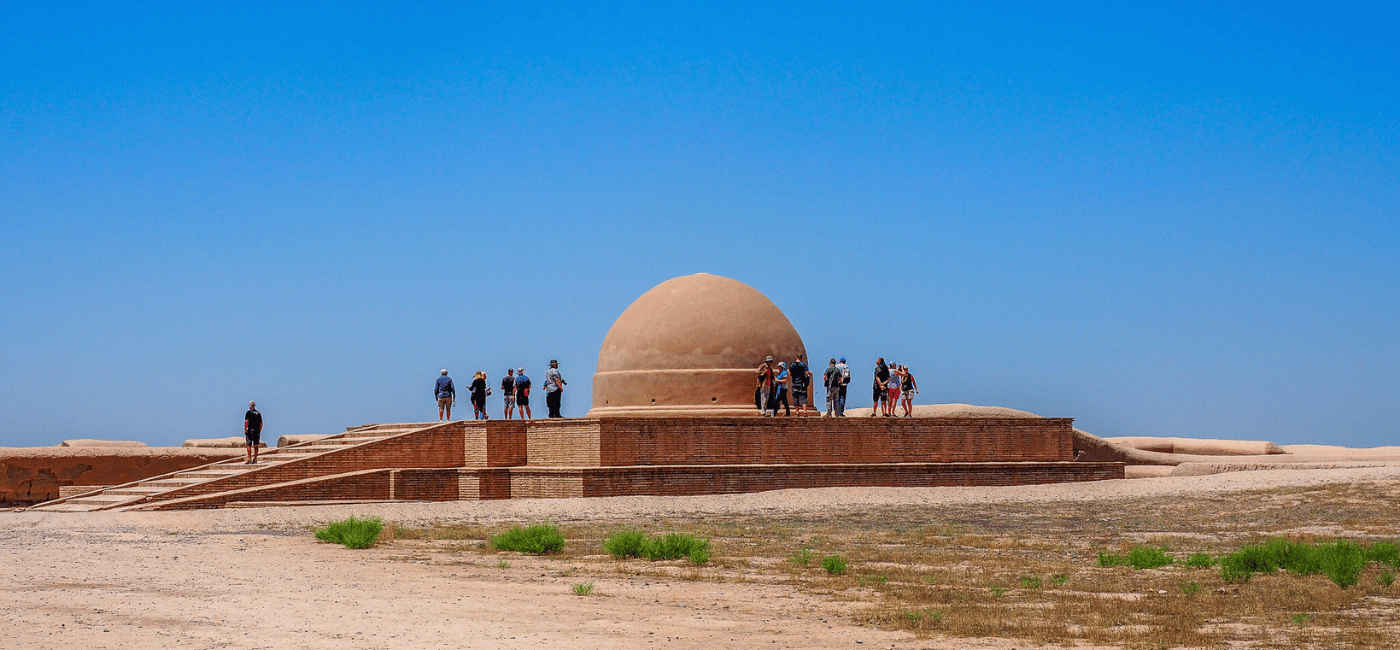Fayaz-Tepa in Termez

Fayaz-Tepa
The Fayaz tepa complex is located in Termez, near the northwestern ruins of old Termez. In 1968, Absad Beknaev found a sculpture of Buddha made of alabaster in the dunes, which was later transferred to the Museum of Local Lore. In 1968-76, this find was studied by L.I. Albaum.
After the Fayeztepa square was cleared of the embankment of sand dunes, the study of the architecture of the monument began. Fayaztepa consists of three monumental buildings; in the central part there is a temple, in the north-western part there is a monastery and in the south-east there are household buildings.
The total area of the complex is 1.5 sq. km. One of the constituent parts is a stupa, unlike other structures, located not in the central part, but outside the square, which is parallel to the sacred altar. These parts are connected by a path lined with bricks and stones that crosses the square. In the temple, the walls of which are decorated with various colorful drawings, stands the monument of Buddha (Bodhisattva). Once along the walls there were monuments dedicated to Buddha, the height of which reached four meters.
Initially, many monuments were red; later they were covered with gold paint. On the southern part of the temple there is an image of Buddha dressed in red robes. On both sides of the Buddha, there are silhouettes of two people in long robes with buckles on their shoulders. One of these people is depicted at the time of worshiping the Buddha.
Also, on the eastern wall of the shrine, you can see traces of once applied wall painting. And on the clay pieces of the inner part of the room, you can see images of the faces of various people. On one of the clay fragments, the size of which is 60 × 80 cm, an image of two men was found, whose faces are directed towards the Buddha. From these two figures worshiping the Bactrian Buddha, it can be inferred that the Buddha was an idol to worship. In this room, you can find a large number of pieces of the monument made of plaster.
Along the eastern part of the wall, a special pedestal of burnt bricks was built, intended for sculptures, and the surface of this pedestal is evenly covered with fragments of stones. Most of the statues are made from a mixture of clay and straw, the outside of which is covered with plaster.
The heads of these statues were placed in special shapes, and the arms and legs were made separately and then attached to the body of the statues. Of all the statues located in the Fayaztepa complex, the upper part of the Buddha statue, made of alabaster, is the most attractive. The collected, black hair framing the handsome face of the Buddha gives the statue a charming look. This decoration of the Buddha statue is the first in the heritage of the Kushanid period.
Opposite the door to this sacred temple, a rare piece of art was found - a triad, created from a single piece of marble stone. In the center of the triad, Buddha is depicted sitting on the branches of the sacred bodha tree, and next to him are two monks worshiping him. Two coins of Kanishka and one of Vasudeva were found in the temple.
The courtyard of the temple has the shape of a regular rectangle measuring 33×20 m, where the doors of the monks' rooms are located on four sides. Inside the courtyard there is a large one-piece hall; its walls are decorated with multi-colored drawings that have survived only on its lower parts. Soup is located along this hall. In the northwestern part of the courtyard, there is a small pond in the form of a trapezoid, which is made of fragments of marble.
A special hole is made at the bottom of this pond to drain the water. This hole was made in the form of an open mouth of a lion. The water in this kind of pond was clean and drinkable. This lion belongs to the era of Kushanid art, a strong and powerful Buddha is reflected in its image.
The second part of the religious structure was the monastery, which is connected to the temple by a door leading to the courtyard. Monks and students of the monastery lived in the rooms located on the territory of the monastery, and hostels for pilgrims were located in the study rooms and offices.
On the walls of the rooms, special shelves were built, where lanterns with wicks were located. Soups were built along the walls of certain rooms, intended for the installation of Buddha statues on them. Thus, the monks, their disciples and pilgrims offered their prayers in the central part of the temple when religious activities were suspended for some time.
List of Top Sights to See in Termez
| Al Hakim At-Termiz Mausoleum | Fayaz Tepa |
| Fortress Kirk Kiz | Friendship Bridge |
| Jarkurgan Minaret | Karatepa |
| Kokildor-Ota Khanaka | Stupa Zurmala |
| Sultan Saodat Ensemble |

